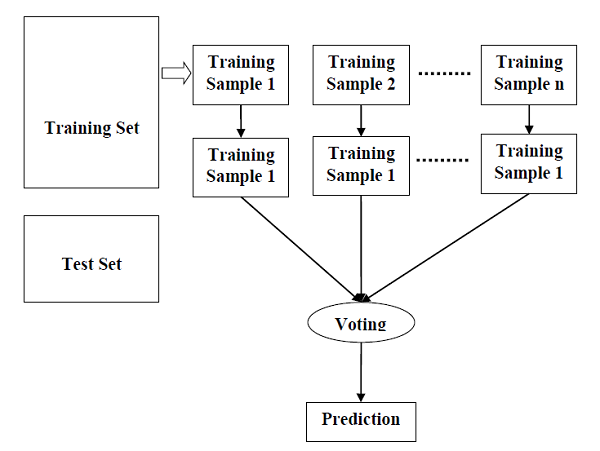- R-随机森林
- R随机森林
- R随机森林(1)
- R-随机森林(1)
- R 编程中用于分类的随机森林方法(1)
- R 编程中用于分类的随机森林方法
- 随机森林python(1)
- 随机森林python代码示例
- 机器学习-随机森林算法
- 机器学习-随机森林算法(1)
- 随机算法|第2组(分类和应用)
- 随机算法|第2组(分类和应用)(1)
- R 编程中的随机森林方法(1)
- R 编程中的随机森林方法
- 算法分类示例(1)
- 算法分类示例
- 算法分类示例
- 算法分类示例
- 算法分类示例
- 算法分类示例
- 算法分类示例(1)
- 算法分类示例(1)
- 算法分类示例(1)
- 分类算法的分类(1)
- 分类算法的分类
- Python中的随机森林回归
- Python中的随机森林回归(1)
- 随机森林回归器 python (1)
- 随机森林回归器 python 代码示例
📅 最后修改于: 2020-12-10 05:37:43 🧑 作者: Mango
介绍
随机森林是一种监督学习算法,可用于分类和回归。但是,它主要用于分类问题。众所周知,森林由树木组成,更多的树木意味着更坚固的森林。同样,随机森林算法在数据样本上创建决策树,然后从每个样本中获取预测,最后通过投票选择最佳解决方案。它是一种集成方法,比单个决策树要好,因为它通过对结果求平均值来减少过度拟合。
随机森林算法的工作
我们可以通过以下步骤来了解随机森林算法的工作原理-
-
步骤1-首先,从给定的数据集中选择随机样本。
-
步骤2-接下来,该算法将为每个样本构造一个决策树。然后它将从每个决策树中获得预测结果。
-
步骤3-在此步骤中,将对每个预测结果进行投票。
-
步骤4-最后,选择投票最多的预测结果作为最终预测结果。
下图将说明其工作方式-

用Python实现
首先,从导入必要的Python包开始-
import numpy as np
import matplotlib.pyplot as plt
import pandas as pd
接下来,如下所示从其网络链接下载iris数据集:
path = "https://archive.ics.uci.edu/ml/machine-learning-databases/iris/iris.data"
接下来,我们需要为数据集分配列名,如下所示:
headernames = ['sepal-length', 'sepal-width', 'petal-length', 'petal-width', 'Class']
现在,我们需要将数据集读取为pandas数据框,如下所示:
dataset = pd.read_csv(path, names=headernames)
dataset.head()
| sepal-length | sepal-width | petal-length | petal-width | Class | |
|---|---|---|---|---|---|
| 0 | 5.1 | 3.5 | 1.4 | 0.2 | Iris-setosa |
| 1 | 4.9 | 3.0 | 1.4 | 0.2 | Iris-setosa |
| 2 | 4.7 | 3.2 | 1.3 | 0.2 | Iris-setosa |
| 3 | 4.6 | 3.1 | 1.5 | 0.2 | Iris-setosa |
| 4 | 5.0 | 3.6 | 1.4 | 0.2 | Iris-setosa |
数据预处理将在以下脚本行的帮助下完成-
X = dataset.iloc[:, :-1].values
y = dataset.iloc[:, 4].values
接下来,我们将数据分为训练和测试拆分。以下代码将数据集拆分为70%的训练数据和30%的测试数据-
from sklearn.model_selection import train_test_split
X_train, X_test, y_train, y_test = train_test_split(X, y, test_size=0.30)
接下来,在sklearn的RandomForestClassifier类的帮助下训练模型,如下所示-
from sklearn.ensemble import RandomForestClassifier
classifier = RandomForestClassifier(n_estimators=50)
classifier.fit(X_train, y_train)
最后,我们需要进行预测。可以在以下脚本的帮助下完成-
y_pred = classifier.predict(X_test)
接下来,按如下所示打印结果-
from sklearn.metrics import classification_report, confusion_matrix, accuracy_score
result = confusion_matrix(y_test, y_pred)
print("Confusion Matrix:")
print(result)
result1 = classification_report(y_test, y_pred)
print("Classification Report:",)
print (result1)
result2 = accuracy_score(y_test,y_pred)
print("Accuracy:",result2)
输出
Confusion Matrix:
[
[14 0 0]
[ 0 18 1]
[ 0 0 12]
]
Classification Report:
precision recall f1-score support
Iris-setosa 1.00 1.00 1.00 14
Iris-versicolor 1.00 0.95 0.97 19
Iris-virginica 0.92 1.00 0.96 12
micro avg 0.98 0.98 0.98 45
macro avg 0.97 0.98 0.98 45
weighted avg 0.98 0.98 0.98 45
Accuracy: 0.9777777777777777
随机森林的利与弊
优点
以下是随机森林算法的优点-
-
它通过平均或组合不同决策树的结果来克服过拟合的问题。
-
与单个决策树相比,随机森林在较大范围的数据项上效果很好。
-
随机森林的方差小于单个决策树。
-
随机森林非常灵活,并且具有很高的准确性。
-
在随机森林算法中不需要数据缩放。即使在没有缩放的情况下提供数据后,它仍保持良好的准确性。
-
在随机森林算法中不需要数据缩放。即使在没有缩放的情况下提供数据后,它仍保持良好的准确性。
缺点
以下是随机森林算法的缺点-
-
复杂性是随机森林算法的主要缺点。
-
与决策树相比,随机森林的建设更加困难且耗时。
-
实现随机森林算法需要更多的计算资源。
-
如果我们有大量的决策树集合,那么它就不太直观了。
-
与其他算法相比,使用随机森林的预测过程非常耗时。